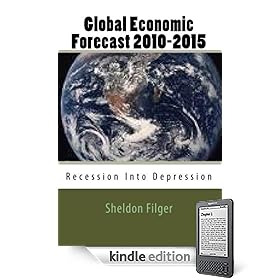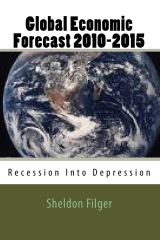Larry Summers, Timothy Geithner and Ben Bernanke may be fated to go down in history as the three horsemen of the global financial and economic apocalypse. Though Fed Chairman Bernanke was inherited by the Obama administration, Geithner, Summers et al were the chosen economic team of the Obama administration. In effect, their selection was the single most important decision made by President Barack Obama in response to the Global Economic Crisis. Regrettably, thus far their performance has been found wanting. Most disconcertingly, many of their public statements are Bush 43 redux, a smorgasbord of overly-optimistic platitudes utterly dichotomized from economic realities. Perhaps the one phrase that is most likely to haunt the Obama administration is one uttered originally by Ben Bernanke in the spring; those perennial “green shoots” that the Fed Chairman could see sprouting amid the recessionary quicksand engulfing the global economy.
Like a barbershop quartet, other senior Obama economic policymakers and advisors sang the happy melodies of these enigmatic green shoots. This happy talk was not without its effect; in large measure the bear market rally on Wall Street, what others have referred to as a “dead cat bounce,” was a by-product of investor optimism fuelled by the green shoots serenade flowing from the banks of the Potomac.
As Yogi Berra would say, “it’s déjà vu all over again.” George W. Bush’s economic team was also full of joyful verbiage, until the floor literally collapsed from under them with the disintegration of Lehman Brothers. In the case of the Obama economic crisis management team, however, this theory of hope triumphing over reality has been executed with even more creative dexterity. With all credible mathematical indicators revealing that most of the largest U.S. banks are functionally insolvent, the Treasury Department concocted a totally cosmetic set of so-called “stress tests” to “prove” that these insolvent banks were, actually, “solvent.” In addition, by forcing changes in the FASB rules through political intervention, some of these banks were even able to show a profit in their Q1 results.
The June unemployment numbers, however, are throwing a cold dose of reality in the direction of the pontificators of ephemeral green shoots. With the publicly released U3 Labor Department jobless report showing the level of U.S. unemployment having risen to 9.5%, and the less publicized but far more accurate U6 report showing actual unemployment and underemployment now at a staggering 16.5%, it is quite clear that the American economy, along with most of the planet, is still undergoing a painful contraction. The fact that one in six Americans is either unemployed or trapped in low-paying part-time employment due to the lack of full-time positions, is a far more significant economic indicator than short-term gyrations on Wall Street or periodic upward anomalies confronting an otherwise downward economic trend.
Amid all the green shoots fantasizing, it must be recalled that the United States economy depends on the spending of the U.S. consumer for more than 70% of its aggregate demand. The real significance of rising unemployment, exchanging full-time jobs for part-time employment and the fear factor inhibiting spending by those who think they may lose their jobs, is a radical contraction in consumer spending. It is this reality more than any other that is weighing heavily on the nation’s economic superstructure. Not only is joblessness rising. After years of American consumers spending more than they earned, they have now shifted radically towards a high level of savings. Transitioning from a negative savings rate, the U.S. wage earner now banks nearly 7% of his/her declining take- home pay, despite virtually zero interest being offered to savers due to the Federal Reserve’s zero interest monetary policy.
The American consumer is scared, and is not being seduced by talk of green shoots emanating from Washington. With consumer spending undergoing significant contraction not only in the United States but in virtually all major economies throughout the globe, increasing pressure will bear on securitized investments based on loan portfolios directly or indirectly linked to consumer spending. Retail and shopping mall mortgages will witness higher levels of defaults, in conjunction with the already virulent afflictions hammering sub prime and prime residential mortgages, commercial office space mortgages, consumer loans and credit card debt.
The Obama administration apparently believed that the original $700 billion TARP Wall Street bailout passed by Congress in the last weeks of the Bush administration, and President Obama’s $800 billion stimulus spending bill, would suffice to stabilize the economy and put the brakes on the free fall in employment numbers. However, jobs are still being shredded each month by the hundreds of thousands, while banks still suffer from balance sheets saturated with toxic assets. The FDIC has already closed more U.S. banks this year than in all of 2008.
As I indicated in a recent piece, there is already serious discussion occurring in the corridors of power in Washington on the necessity of a second stimulus spending package. This is an acknowledgement that the Obama economic crisis team, thus far, has been an abject failure. However, with so much money already having been borrowed by the U.S. government on a variety of schemes supposedly aimed at saving the economy, further large doses of public debt bring along very dangerous negative implications of their own.
In a recent column in the Financial Times of London, Mohamed A. El-Erian, chief executive and co-chief investment officer of PIMCO, the world’s largest bond trading firm, offered the following observation:
“The bottom line is a simple yet powerful one. The global crisis is morphing again. Having already contaminated (in a sequential and cumulative manner) housing, finance and the consumer, it is now threatening the potency and credibility of the economic policy making apparatus. As far as I can see, there are no first best policy responses that are readily available and easy to implement. Instead, the economy will continue to struggle, navigating both the adverse implications of last year’s financial crisis and the unintended consequences of the experimental policy responses. Given the inevitable socio-political dimensions, this story will play out well beyond the realm of the economy, policymaking and markets.”
Mohamed El-Erian is not offering green shoots, but he does speak the truth. Unfortunately, the truth is so bitter, it is unlikely that President Obama’s principal economic advisors will face up to the harsh and even brutal realities of the Global Economic Crisis until it is far too late for any policy response to be effective.






